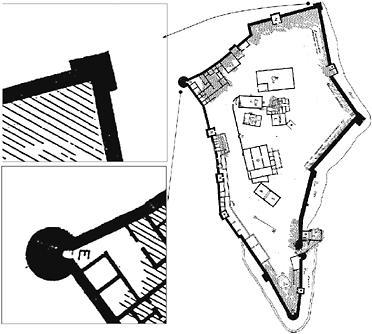Muslim Fortresses in the Levant: Between Crusaders and Mongols (33 page)
Read Muslim Fortresses in the Levant: Between Crusaders and Mongols Online
Authors: Kate Raphael
Tags: #Arts & Photography, #Architecture, #Buildings, #History, #Middle East, #Egypt, #Politics & Social Sciences, #Social Sciences, #Human Geography, #Building Types & Styles, #World, #Medieval, #Humanities


Figure 1.14
Chart showing the increase in width of Crusader curtain walls
the Mamluks did not see any reason to improve the methods and quality of curtain walls in the fortresses they inherited from the Ayyubids, and more often than not the curtain walls were left just as they were found. This was not for lack of skill, as it is quite easy to distinguish the fine masonry and careful construction of the immense Mamluk towers at that stand in great contrast to the rather poor Ayyubid curtain walls.
that stand in great contrast to the rather poor Ayyubid curtain walls.
Towers, arrow slits and fighting galleries
Towers have often been defined by form and attributed to a particular tradition of building in a certain region or period.
171
Thee have been several attempts to follow the development of towers through the twelfth and thirteenth centuries, making comparisons between those built by the Muslim rulers and those built by Crusaders and Armenians.
162
The results were seldom conclusive.
My initial research supposition was that the strength of an Ayyubid fortress relied to a great extent on its towers and the fighting capabilities of its garrison archers. Although it is best to draw conclusions at the end, I present this assumption at the head of the discussion since my first field surveys showed the towers in this group to be constructed with greater care and attention than most of the curtain walls.
 is the earliest fortress of the four. It has two distinct types of towers, belonging to two different building phases. The smaller rectangular towers (measuring: 4 × 3m, 4 × 4m and 5 × 5m), were probably constructed when the fortress was first built, in the early 1170s. According to Barthoux, who surveyed and charted the fortress, the towers were used mainly for accommodation.
is the earliest fortress of the four. It has two distinct types of towers, belonging to two different building phases. The smaller rectangular towers (measuring: 4 × 3m, 4 × 4m and 5 × 5m), were probably constructed when the fortress was first built, in the early 1170s. According to Barthoux, who surveyed and charted the fortress, the towers were used mainly for accommodation.
173
The round towers guarding the main gate (measuring 3m in diameter), the L-shaped tower in the northwest and the two large round solid towers (5m and 7m in diameter), were all built by in 582/1186, as attested by the inscriptions found at the site (
in 582/1186, as attested by the inscriptions found at the site (
Figure 1.15
).
174
This is the only site in the group where solid towers are to be found, although it would seem that this building technique gives towers extra protection against mining and any type of projectiles. Solid round towers are fairly rare in rural and frontier fortifications of the Ayyubid period in this region. However, towers of similar size and design can be seen at the fortress of Habonim north of Caesarea (known in the Arabic sources as Kafr Lab and in the Latin charters as Cafarlet),
175
probably first built by the Umayyad Caliph Hishām (r. 742–3) and the fortresses of Mīnat (Ashdod Yam) dated to the Umayyad period.
(Ashdod Yam) dated to the Umayyad period.
176
Other examples of solid turrets can be found at Ascalon, where the towers along the city walls, originally constructed during the Byzantine period, were rebuilt by the Umayyads and later repaired by the Fatimids.
177
On the whole, the towers of are fairly modest in size. The number of soldiers they could each have accommodated during an assault was small (fewer than 10), and as the rooftop was the only fighting level it seems very doubtful that the towers were ever used for the operation of siege machines.
are fairly modest in size. The number of soldiers they could each have accommodated during an assault was small (fewer than 10), and as the rooftop was the only fighting level it seems very doubtful that the towers were ever used for the operation of siege machines.
178
As for archers’ galleries, remains of arrow slits can be seen only along one very short section of the curtain wall. Along the wider parts of the wall there is a
chemin de ronde
, connecting the towers, allowing men to move round the fortress walls quickly.
179

Figure 1.15
Towers at
The towers built at ,
, and Mount Tabor developed in a fairly similar way, with no surprises or striking innovations. In spite of the many advantages of the round tower, it seems to have gone out of favor. This mode,” which can hardly be explained, changed again and round towers made a return in the first decades of the Mamluk period. In the interim the Ayyubids found rectangular towers more than adequate for their needs.
and Mount Tabor developed in a fairly similar way, with no surprises or striking innovations. In spite of the many advantages of the round tower, it seems to have gone out of favor. This mode,” which can hardly be explained, changed again and round towers made a return in the first decades of the Mamluk period. In the interim the Ayyubids found rectangular towers more than adequate for their needs.
